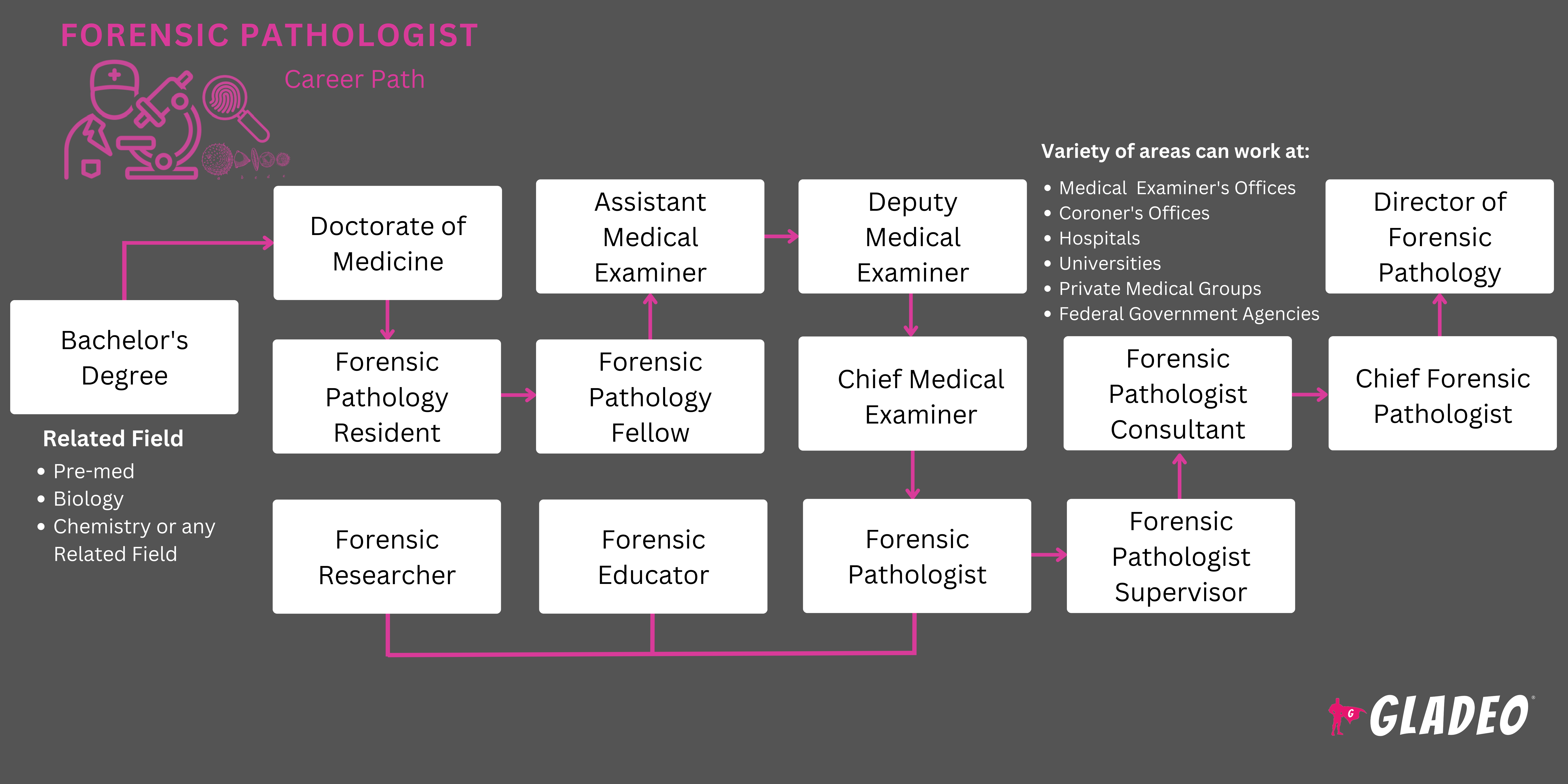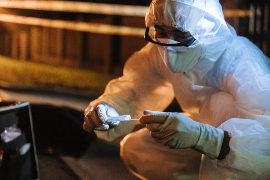Mga spotlight
Anatomic Pathologist, Cytopathologist, Dermatopathologist, Hematopathologist, Neuropathologist, Oral Pathologist, Pathologist, Surgical Pathologist, Medical Examiner, Coroner, Forensic Medical Specialist
Forensics is the use of scientific techniques to investigate crimes and examine evidence for legal proceedings. Pathologists are medical doctors who diagnose patients by examining tissues, cells, and bodily fluids.
Put the two together and you get a Forensic Pathologist—a doctor who examines the bodies of deceased persons to determine the manner and cause of death. This is often done for legal purposes when the circumstances surrounding the death seem sudden, suspicious, or unexplained.
Thus, Forensic Pathologists play a crucial role in the medical and criminal justice systems, working closely with law enforcement to provide vital information that can solve crimes and offer closure to families.
- Collaborating with law enforcement and legal teams to aid in investigations
- Applying knowledge to solve cases and uncover the truth
- Making significant contributions to the criminal justice system and public health
Oras ng trabaho
- Typically employed full-time, Forensic Pathologists may work long hours, including nights and weekends, especially when dealing with high-profile cases. Their work requires precision and attention to detail, often under time constraints.
Mga Karaniwang Tungkulin
- Work with law enforcement and legal teams on cases involving deceased persons
- Obtain details related to the circumstances of death (i.e. location, time the body was found, position of the body, witness statements, environmental conditions, etc.)
- Review medical histories and conduct autopsies to help determine causes and manners of death (with manner categories such as natural, homicide, suicide, accident, and undetermined)
- Examine bodies for abnormalities or signs of trauma. Determine any signs of disease post-mortem
- Collect tissue samples. Analyze samples in a lab for signs of disease or poison
- Estimate times of death
- Document findings in detailed reports, including observations and lab results
- Testify in court about findings and opinions
- Create reports for public health organizations or law enforcement, as necessary
- Train and mentor junior pathologists and medical students
Karagdagang Pananagutan
- Participate in public health studies. Help identify public health issues by analyzing death rate trends
- Inform legal and public health agencies of suspicious or significant findings
- Consult on medical cases with undetermined causes of death
- Engage in continuous education and research activities. Stay informed about advancements in forensic science and pathology
Soft Skills
- Kakayahang magtrabaho nang nakapag-iisa
- Analitikal
- Kritikal na pag-iisip
- Pagkausyoso
- Mabusisi pagdating sa detalye
- Emotionally resilient
- Etikal
- mapagmasid
- Pagtitiyaga
- Pisikal na tibay
- Pagtugon sa suliranin
- Pagkamaparaan
- Kamalayan sa kaligtasan
- Tamang paghuhusga at paggawa ng desisyon
- Malakas na kasanayan sa komunikasyon
Teknikal na kasanayan
- Ballistic analysis
- Bloodstain pattern analysis
- Chemical analysis methods
- Digital imaging techniques
- Entomology for estimating the time of death
- Forensic anthropology
- Forensic information technology tools
- Forensic odontology
- Microscopic analysis and histopathology
- Molecular biology techniques
- Personal protective equipment
- Psychopathology
- Pagsasalita sa publiko
- Radiology and imaging techniques, such as CT scans and MRIs
- Statistical methods for analyzing epidemiological data
- Teknikal na pagsulat
- Government health departments
- Mga ospital
- Mga ahensyang nagpapatupad ng batas
- Medical examiner or coroner offices
- Universities and research institutions
Forensic Pathologists require a unique blend of medical expertise and emotional resilience. The job can be emotionally taxing because of the interaction with deceased individuals and the involvement in legal cases.
Workers in this field must be able to maintain a high degree of detachment as they rigorously try to find clues that will reveal causes and manners of death. In some cases, they may have to visit crime scenes themselves. Precision, timeliness, and meticulous attention to detail are paramount, with the outcomes often influencing legal decisions and affecting the lives of others.
All in all, it’s a complex, high-stakes profession that requires personal sacrifices and a commitment to continuous learning. However the results of the work can be rewarding, such as helping grieving families find closure and, in some cases, aiding in the conviction of dangerous criminals.
The field of forensic pathology is evolving thanks to technological advancements like digital pathology and advanced imaging techniques for non-invasive autopsies. There’s also an increasing focus on molecular autopsies, using genetic testing to uncover hereditary diseases and genetic anomalies. These capabilities are enhancing the accuracy of cause-of-death determinations.
Forensic Pathologists also play a pivotal role in public health, via initiatives that monitor and analyze mortality trends. Their findings can inform public health policies aimed at preventing deaths, such as from drug overdoses and environmental factors like industrial toxins.
Social media is even helping forensic investigations by providing crucial information and leads. In addition, online platforms are greatly facilitating networking and knowledge sharing within the forensic pathology community!
Individuals drawn to a career in forensic pathology often have a strong interest in science, particularly biology and chemistry. They may have been intrigued by puzzles and mysteries, eager to understand how things work, especially about the human body and health.
- Forensic Pathologists undergo ~13 years of education and training, starting with a bachelor’s degree, typically in a science field such as biology, chemistry, or forensic science
- Note, there’s no specifically required undergraduate major, but you’ll have to establish a solid foundation for graduate medical school (which can be tough to get into). Plus you may need to knock out specific prerequisite courses, so check with the medical school program you plan on applying to later
- Following the bachelor’s, students must enroll in an accredited medical school to complete a Doctor of Medicine (MD) or Doctor of Osteopathy (DO) program. This usually takes four years to finish
- Note, students must take the Medical College Admission Test (MCAT), sometime during or after their junior year, and submit their scores with their med school applications
- After medical school, they start the medical licensure process by passing the United States Medical Licensing Examination (for MDs) or Comprehensive Osteopathic Medical Licensing Examination (for DOs)
- Next is matching to a ~4-year pathology residency program to gain a comprehensive knowledge of pathology, including both anatomic and clinical pathology, disease mechanisms, diagnostic techniques, and laboratory skills
- Like all residencies, pathology residencies are competitive and there’s no guarantee that a medical school graduate will be accepted into a residency program
- Students who don’t match up with a residency through the National Resident Matching Program can still try through the Supplemental Offer and Acceptance Program.
- After residency, Forensic Pathologists do a 1 to 2-year fellowship specializing in principles and practices related to the legal aspects of medicine and death investigation
- This includes performing autopsies and interpreting toxicological analyses
- Forensic Pathologists then apply for certification from the American Board of Pathology
- Certification requires passing two exams, one written and one with a practical component
- In some cases, additional state-specific licensure is required
- Lastly, Maintenance of Certification is an ongoing education and professional development requirement necessary to stay updated with advancements in forensic science, legal requirements, and medical technologies
- Prospective Forensic Pathologists should seek accredited medical schools with strong pathology programs, clinical rotation opportunities, and top-notch research facilities
- Research the faculty biographies to review their current research and past awards and work
- Isaalang-alang ang halaga ng matrikula, mga diskwento, at mga oportunidad sa lokal na iskolarship (bilang karagdagan sa tulong na pederal sa pamamagitan ng FAFSA )
- Read about a day in the life of a Forensic Pathologist!
- Focus on coursework in biology, chemistry, anatomy, physiology, math, and physics. It’s also helpful to have speech or debate courses
- Talk to your high school advisor about advancement placement classes to prepare you for college
- Strive for good grades all around so you can have a competitive GPA when applying to colleges for your undergraduate degree
- Decide what you want to major in as an undergraduate, keeping in mind that you are laying the foundation for medical school later! Select your electives carefully so you’ll have a strong pre-med foundation in chemistry, biology, math, and other prerequisites
- Participate in student clubs related to science, medicine, pathology, or forensic science
- Assist with research projects and attend workshops where you can gain practical hands-on experience
- Forensic Pathologists may need to learn about subjects ranging from toxicology and serology to firearms, ballistics, and trace evidence
- Keep up your GPA because it’s tough to get into medical school. On average, medical schools have a 40% acceptance rate. Try to get academic honors and awards
- Study hard for the Medical College Admission Test (MCAT)
- Look for medical or forensics-related part-time jobs, volunteer opportunities, or internships—especially at medical examiner or coroner offices, if possible
- Keep a draft medical school application listing all of your relevant experiences and skills
- Maintain your physical fitness to keep up with the long hours and demands of school and the job afterward!
- Think about who you want to list as references and who can write letters of recommendation for your med school application. You’ll need 3 to 5 letters, ideally from professors in the medical field
- When ready, apply to med school using:

- While in medical school, do your best during clinical rotations (aka clerkships) and try to earn honors or high pass grades, especially in your pathology specialization
- Your performance during this rotation will demonstrate your potential for success as a resident!
- After graduating from medical school and passing the applicable licensing exam (the United States Medical Licensing Examination for MDs, or Comprehensive Osteopathic Medical Licensing Examination for DOs), it’s time to try and match for a residency program
- Technically, your first pathologist job will be as a resident in a pathology residency program! Residents are working doctors and legally recognized as physicians, but to practice independently they must finish residency
- Note, that residency programs pay a stipend to residents, which is considered a salary. However, it’s lower than the salaries earned by physicians who have completed all of their education and training
- Start preparing your residency application well in advance, including letters of recommendation from faculty or mentors who can attest to your abilities
- Highlight relevant clinical rotations, electives, and extracurricular activities you’ve finished
- Do your research on residency programs to learn about their culture, values, and other details, so you can tailor your application effectively
- Write a compelling personal statement that conveys your passion for the specialty, your career goals, and the reasons why you’re a unique candidate!
- Try to get high scores on the United States Medical Licensing Examination (USMLE) or Comprehensive Osteopathic Medical Licensing Examination (COMLEX)
- Prepare for interviews by learning about the program staff or possible interviewers, the program itself, and program-related topics
- After your residency, it’s time to proceed to a fellowship, an advanced training program lasting 1 or 2 years
- Fellowships provide practical experience with autopsies and forensic pathology services, as well as academic instruction in death scene investigation, post-mortem examinations, and court testimony skills
- Upon completion of the fellowship, Forensic Pathologists take the American Board of Pathology’s board certification exam in forensic pathology
- The exam is computer-based and consists of 225 questions in the Written/Practical sections and 50 questions in the Virtual Microscopy sections
- Subject areas include:
- “Pathology and interpretation of natural disease, therapy, and trauma,
- “Interpretation of injury patterns and stigmata,
- “Pathology and certification of natural and violent deaths,
- “Interpretation of clinical and postmortem chemistries and
toxicologies, - “Molecular biology, forensic odontology, physical anthropology, and
- “Criminalistics, public health, jurisprudence, management, and safety”
- In some cases, additional state-specific licensure is required
- Once all residency, certification, and licensure are done, Forensic Pathologists can really start to advance their careers, gaining experience in high-profile cases
- Consider specialization in areas like neuropathology, pediatric pathology, or forensic anthropology for specialized investigative roles
- Slowly progress toward leadership roles like Senior Forensic Pathologist/Chief Medical Examiner
- If you’re interested in teaching and research, look into faculty positions, department chairs, or lead research programs in medical schools and universities
- Serve as an expert witness or consultant in legal cases, or in advisory roles in policy development
- Mentor students and residents. Carefully adhere to all safety protocols
- Maintain certification via ongoing education and professional development
- Elevate your profile through research publications, conference speaking, and panel participation. Seek leadership roles in professional organizations
- Work with international organizations on global health initiatives, disaster response, and human rights investigations
Mga website
- Accreditation Council para sa Graduate Medical Education
- American Academy of Forensic Sciences
- American Association of Colleges of Osteopathic Medicine Application Service
- American Board of Criminalistics
- American Board of Forensic Entomology
- American Board of Forensic Toxicology
- American Board of Medicolegal Death Investigators
- American Board of Pathology
- American Chemical Society
- American Medical College Application Service
- American Society for Investigative Pathology
- American Society of Crime Lab Directors
- Association of Firearm and Tool Mark Examiners
- Association of Forensic DNA Analysis and Administrators
- Clandestine Laboratory Investigators Association
- Kolehiyo ng mga American Pathologist
- Comprehensive Osteopathic Medical Licensing Examination
- International Association for Identification
- International Association of Bloodstain Pattern Analysts
- International Crime Scene Investigators Association
- Law Enforcement and Emergency Services Video Association International
- Medical College Admission Test
- Microscopy Society of America
- Mid-Atlantic Association of Forensic Scientists
- Midwestern Association of Forensic Scientists
- National Association of Medical Examiners
- Northeastern Association of Forensic Scientists
- Society of Forensic Toxicologists
- Southern Association of Forensic Scientists
- Southwestern Association of Forensic Scientists
- Texas Medical and Dental Schools Application Service
- Pagsusuri sa Paglilisensyang Medikal ng Estados Unidos
Mga libro
- Diagnostic Pathology: Forensic Autopsy, by Mary Ann Sens MD PhD and Rhome Hughes M.D
- DiMaio’s Forensic Pathology (Practical Aspects of Criminal and Forensic Investigations), by Vincent J.M. DiMaio and D. Kimberley Molina
- Principles of Forensic Pathology: From Investigation to Certification, by Susan F. Ely and James R. Gill
Forensic Pathologists have vital but demanding jobs that can take an emotional and physical toll after a while. If you’re interested in reviewing some additional career fields, check out the options below!
- Biological Technician
- Chemist and Materials Scientist
- Clinical Pathologist
- Coroner
- Detective at Criminal Investigator
- Digital Forensics Analyst
- Fraud Examiner, Investigator, and Analyst
- Histology Technician
- Intelligence Analyst
- Legal Medicine Practitioner
- Medical and Clinical Laboratory Technician
- Medical Researcher
- Police and Detective
- Police Identification and Records Officer
- Private Detective and Investigator
- Public Health Administrator
- Toxicologist
Newsfeed

Mga Tampok na Trabaho

Mga Online na Kurso at Tool

Mga Inaasahan sa Taunang Sahod
New workers start around $90K. Median pay is $118K per year. Highly experienced workers can earn around $147K.
Mga Inaasahan sa Taunang Sahod
New workers start around $80K. Median pay is $88K per year. Highly experienced workers can earn around $101K.
Mga Inaasahan sa Taunang Sahod
New workers start around $62K. Median pay is $80K per year. Highly experienced workers can earn around $104K.







